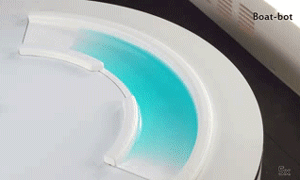Origami Robot Uses Exoskeletons To Perform Tasks
You’ve probably seen origami ‘robots’ before: flat sheets of metal or plastic that fold into bots that can walk, climb, and even swim. They’re not of much practical use right now, but they represent a promising path for robot development. (We’ve even made them out of meat so they can work inside the body.) Now, in a bid to augment the bots’ abilities, researchers at MIT’s Computer Science and Artificial Intelligence Laboratory (CSAIL) have come up with a new tool for them: origami exoskeletons.
In a paper published today, researchers describe four exoskeletons, each made out of a plastic sheet that folds into a predefined shape when heated for a few seconds. There’s a boat-shaped exoskeleton and a glider: one for ‘walking’, and another that folds up into a crude wheel for faster movement. Each exoskeleton can be donned in turn by a tiny lead bot called Primer. This isn’t a robot as we usually think of them, but a small magnetic cube that can be controlled remotely using magnetic fields.
In the video above you can see Primer trundle across a tabletop, pick up an exoskeleton, and explore new terrain with it. It’s all very rudimentary, but it’s a proof-of-concept that shows how we could make robots that adapt to different environments. Primer can even wear multiple exoskeletons at once to combine their abilities, and can shrug them off by vibrating for a minute or so.

“If we want robots to help us do things, it’s not very efficient to have a different one for each task,” said CSAIL’s Daniela Rus, the project’s lead, in a press release. “With this metamorphosis-inspired approach, we can extend the capabilities of a single robot by giving it different ‘accessories’ to use in different situations.”
In the future, the researchers imagine this sort of approach to robot design could help up make multifunctional bots that can perform complex tasks remotely. They could be used for deep-sea mining operations, for example, or for building colonies in space. These are locations where you don’t want to waste resources shipping out lots of different bots for different jobs, so it’s more efficient to send one with a set of origami tools. As Rus said: “Why update a whole robot when you can just update one part of it?”

Comments are closed, but trackbacks and pingbacks are open.